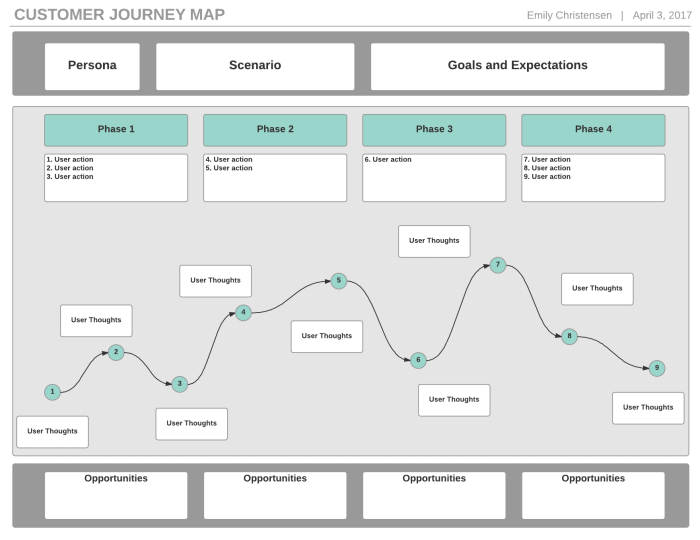AI for customer journey mapping is revolutionizing how businesses understand and interact with their customers. By leveraging the power of artificial intelligence, companies can gain unprecedented insights into customer behavior, preferences, and pain points. This allows for personalized experiences, automated processes, and a more streamlined customer journey, ultimately leading to increased satisfaction and loyalty.
Imagine a world where every customer interaction is tailored to their individual needs, where marketing campaigns are targeted with pinpoint accuracy, and where customer service issues are resolved proactively before they even arise. This is the promise of AI-powered customer journey mapping, and it’s a reality that’s rapidly becoming accessible to businesses of all sizes.
Introduction to AI in Customer Journey Mapping: AI For Customer Journey Mapping

Customer journey mapping is a powerful tool that helps businesses understand the experiences their customers have with their products or services. It involves mapping out all the touchpoints a customer has with a business, from initial awareness to post-purchase interactions.
By understanding the customer journey, businesses can identify areas for improvement and create more positive experiences for their customers.AI is transforming customer journey mapping by providing valuable insights and automating many of the manual processes involved. It allows businesses to analyze vast amounts of data, identify patterns, and gain a deeper understanding of customer behavior.
Benefits of AI in Customer Journey Mapping
AI offers several benefits for customer journey mapping, enabling businesses to:
- Gain deeper insights into customer behavior:AI can analyze large datasets of customer interactions, including website visits, social media activity, and customer support inquiries, to identify patterns and trends that might not be apparent through traditional methods. This provides a comprehensive understanding of customer behavior at various stages of the journey.
- Personalize customer experiences:By analyzing customer data, AI can identify individual preferences and needs, enabling businesses to personalize interactions and provide tailored experiences. This can include recommending relevant products, providing personalized offers, and tailoring communication based on customer preferences.
- Optimize the customer journey:AI can help identify bottlenecks and pain points in the customer journey by analyzing customer feedback, website analytics, and other data sources. This allows businesses to streamline processes, improve efficiency, and create a smoother experience for customers.
- Predict customer behavior:AI can analyze historical data and identify patterns to predict future customer behavior. This allows businesses to anticipate customer needs, proactively address potential issues, and tailor their marketing and sales strategies accordingly.
- Automate tasks:AI can automate many of the manual tasks involved in customer journey mapping, such as data collection, analysis, and report generation. This frees up time for teams to focus on more strategic initiatives.
How AI Enhances Different Stages of the Customer Journey
AI can enhance various stages of the customer journey, providing valuable insights and automation opportunities:
- Awareness:AI can help identify potential customers by analyzing data from social media, search engines, and other online platforms. This allows businesses to target their marketing efforts more effectively and reach the right audience.
- Consideration:AI can personalize content and recommendations based on customer interests and preferences, helping them make informed decisions and move further down the sales funnel.
- Decision:AI can provide real-time recommendations and answer customer questions, assisting them in making purchase decisions. This can include providing product comparisons, highlighting key features, and addressing concerns.
- Purchase:AI can streamline the checkout process by providing personalized recommendations, simplifying payment options, and offering seamless integration with delivery services.
- Post-purchase:AI can provide personalized support and guidance after the purchase, addressing customer inquiries, resolving issues, and offering relevant recommendations for future purchases.
AI-Powered Customer Journey Mapping Tools and Techniques

AI has revolutionized customer journey mapping, enabling businesses to gain deeper insights into customer behavior and preferences. By leveraging AI-powered tools and techniques, organizations can automate data collection, analyze vast amounts of information, and identify patterns that would be difficult to uncover manually.
AI Tools for Customer Journey Mapping
AI tools play a crucial role in enhancing customer journey mapping by automating data collection, analysis, and insights generation. These tools help businesses understand customer behavior, preferences, and pain points across different touchpoints.
- Data Analysis Platforms:These platforms utilize machine learning algorithms to analyze large datasets from various sources, such as CRM systems, website analytics, and social media. They identify trends, patterns, and customer segments based on data analysis. Examples include Google Analytics, Tableau, and Power BI.
- Chatbot Builders:Chatbots powered by natural language processing (NLP) can interact with customers in real-time, collecting valuable data about their preferences, pain points, and needs. This data can be used to create detailed customer journey maps. Examples include Dialogflow, Botpress, and ManyChat.
- Sentiment Analysis Tools:These tools use AI algorithms to analyze customer feedback, reviews, and social media posts to understand customer sentiment. This information can be incorporated into customer journey maps to identify areas where customer satisfaction is high or low.
How AI Algorithms Enhance Customer Journey Mapping, AI for customer journey mapping
AI algorithms, particularly machine learning and natural language processing, are instrumental in automating and improving customer journey mapping.
- Machine Learning:Machine learning algorithms analyze historical data to identify patterns and predict future customer behavior. This allows businesses to anticipate customer needs and personalize their experiences. For example, machine learning can be used to predict customer churn or identify high-value customers based on their past interactions.
- Natural Language Processing:NLP enables AI tools to understand and interpret human language. This is essential for analyzing customer feedback, reviews, and social media posts to extract valuable insights. NLP can also be used to build chatbots that can interact with customers in a natural and engaging way.
Best Practices for Selecting and Implementing AI Tools
Selecting and implementing AI tools for customer journey mapping requires careful consideration of the business objectives, data availability, and technical expertise.
- Define Clear Objectives:Identify specific goals for using AI in customer journey mapping, such as improving customer satisfaction, reducing churn, or increasing conversion rates.
- Assess Data Availability:Ensure that sufficient data is available to train AI algorithms and generate meaningful insights. This includes data from CRM systems, website analytics, social media, and customer feedback channels.
- Consider Technical Expertise:Evaluate the technical resources and expertise available to implement and manage AI tools. Some tools require specialized skills in data science, machine learning, and NLP.
- Start with a Pilot Project:Begin with a small-scale pilot project to test the effectiveness of AI tools and refine the implementation process before scaling up.
- Monitor and Evaluate Results:Regularly monitor the performance of AI tools and evaluate their impact on key metrics. Make adjustments as needed to optimize the results.
Data Collection and Analysis for AI-Driven Mapping
AI-powered customer journey mapping thrives on the power of data. The richer and more diverse the data collected, the more accurate and insightful the journey maps become. This data serves as the foundation for AI algorithms to analyze and identify key customer behaviors, preferences, and pain points.
Data Collection
Collecting the right data is crucial for building effective customer journey maps. This data can come from various sources, offering a comprehensive view of customer interactions and experiences.
- Customer Interactions: This includes direct interactions with customers, such as phone calls, emails, live chats, and in-person interactions. These interactions provide valuable insights into customer needs, concerns, and overall satisfaction.
- Website Analytics: Data collected from website analytics tools provides insights into user behavior on a website. This includes pages visited, time spent on each page, bounce rates, and conversion rates. This data helps understand how customers navigate the website and identify potential areas for improvement.
- Social Media Data: Social media platforms are rich sources of customer feedback, opinions, and sentiment. Analyzing social media data can reveal customer preferences, brand perception, and potential issues. This data can be collected through social media listening tools and sentiment analysis algorithms.
- Feedback Surveys: Surveys are a direct way to gather feedback from customers. By asking specific questions about their experiences, preferences, and pain points, businesses can gain valuable insights into customer satisfaction and areas for improvement.
AI Analysis of Customer Journey Data
AI algorithms play a crucial role in analyzing the collected data to extract meaningful insights and identify patterns.
- Identifying Customer Pain Points: AI algorithms can analyze customer interactions, feedback, and website behavior to identify common pain points. For example, by analyzing customer support inquiries, AI can identify frequently asked questions or recurring issues. This information helps businesses address these pain points and improve the customer experience.
- Understanding Customer Preferences: AI algorithms can analyze data from various sources, such as website analytics, social media, and surveys, to understand customer preferences. This includes product preferences, purchase habits, and preferred communication channels. This information helps businesses personalize marketing messages, product recommendations, and customer interactions.
- Identifying Behavioral Patterns: AI algorithms can analyze customer data to identify patterns in their behavior. This includes understanding how customers navigate websites, interact with products, and make purchase decisions. This information helps businesses optimize their marketing strategies, website design, and product offerings to better meet customer needs.
Visualizing and Interpreting Complex Data
AI can help visualize and interpret complex customer journey data in a way that is easily understandable and actionable.
- Interactive Journey Maps: AI-powered tools can create interactive journey maps that allow businesses to explore customer journeys in detail. These maps can include data points, customer personas, and key touchpoints, providing a comprehensive view of the customer experience.
- Data Visualization: AI can use data visualization techniques to present complex data in a clear and concise way. This includes using charts, graphs, and dashboards to highlight key insights and trends. This helps businesses identify areas for improvement and make data-driven decisions.
- Predictive Analytics: AI can use predictive analytics to anticipate customer behavior and identify potential issues. This includes predicting customer churn, identifying potential upselling opportunities, and understanding the impact of marketing campaigns. This information helps businesses proactively address customer needs and improve their overall strategy.
Final Thoughts
AI for customer journey mapping is more than just a technological advancement; it’s a fundamental shift in how businesses approach customer engagement. By embracing AI, companies can unlock a wealth of data-driven insights, personalize customer experiences, and automate key processes, ultimately driving business growth and exceeding customer expectations.
As AI technology continues to evolve, we can expect even more innovative and transformative applications in the realm of customer journey mapping, further enhancing the customer experience and shaping the future of business.
Q&A
What are some examples of AI tools used for customer journey mapping?
Popular AI tools for customer journey mapping include data analysis platforms like Google Analytics, chatbot builders like Dialogflow, and sentiment analysis tools like Brand24.
How does AI ensure data privacy in customer journey mapping?
AI-powered customer journey mapping tools should adhere to strict data privacy regulations like GDPR and CCPA. This involves obtaining informed consent, anonymizing data where possible, and implementing robust security measures to protect sensitive customer information.
What are the potential ethical challenges of using AI for customer journey mapping?
Potential ethical challenges include the risk of algorithmic bias, the potential for data misuse, and the need for transparency in how AI is used to influence customer behavior.
